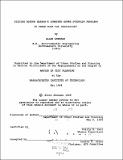| dc.contributor.advisor | Philip B. Herr. | en_US |
| dc.contributor.author | Adelman, Allen | en_US |
| dc.contributor.other | Massachusetts Institute of Technology. Dept. of Urban Studies and Planning. | en_US |
| dc.date.accessioned | 2012-06-05T13:52:40Z | |
| dc.date.available | 2012-06-05T13:52:40Z | |
| dc.date.copyright | 1988 | en_US |
| dc.date.issued | 1988 | en_US |
| dc.identifier.uri | http://hdl.handle.net/1721.1/71073 | |
| dc.description | Thesis (M.C.P.)--Massachusetts Institute of Technology, Dept. of Urban Studies and Planning, 1988. | en_US |
| dc.description | Includes bibliographical references. | en_US |
| dc.description.statementofresponsibility | by Allen Adelman. | en_US |
| dc.format.extent | 118 leaves | en_US |
| dc.language.iso | eng | en_US |
| dc.publisher | Massachusetts Institute of Technology | en_US |
| dc.rights | M.I.T. theses are protected by
copyright. They may be viewed from this source for any purpose, but
reproduction or distribution in any format is prohibited without written
permission. See provided URL for inquiries about permission. | en_US |
| dc.rights.uri | http://dspace.mit.edu/handle/1721.1/7582 | en_US |
| dc.subject | Urban Studies and Planning. | en_US |
| dc.title | Solving Boston Harbor's combined sewer overflow problem : is there room for innovation? | en_US |
| dc.type | Thesis | en_US |
| dc.description.degree | M.C.P. | en_US |
| dc.contributor.department | Massachusetts Institute of Technology. Department of Urban Studies and Planning | |
| dc.identifier.oclc | 19491899 | en_US |
